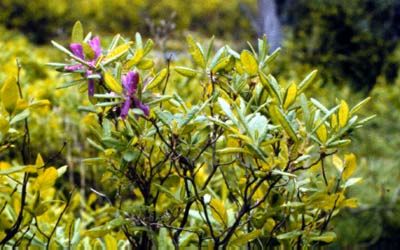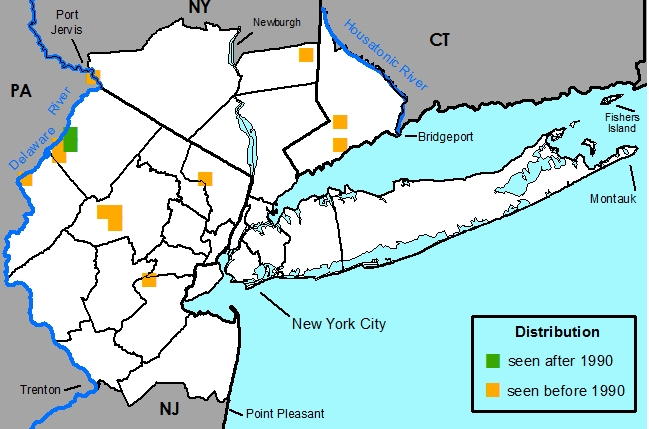Rhododendron canadense (L.) Torr. - Rhodora
Common Names
RhodoraField Identification
A rare shrub of wetlands with distinctive, three-petaled flowers: The upper petal is three-lobed and formed from the fusion of three petals; the lower two petals are free.Poisonous properties
Disclaimer: The information provided here is for reference and historical use. If you believe you have been poisoned, please contact the Poison Control Office near you (look for the number in the front of the phone book).
May produce poisonous honey.
Nomenclature
*Rhodora canadense L., Sp. Pl., ed. 2, 561. 1762. *Hochenwartia canadensis (L.) Crantz, Inst. Rei Herb. 2: 469. 1766. *Rhododendron rhodora J. F. Gmelin, Syst. Nat., ed. 1791, 2(1): 694. 1792. *Rhododendron canadense (L.) Torr., [Annual Rep. Geol. Surv. 1839] State of New York, Documents of Assembly no. 50: 151. 1840. *Azalea canadensis (L.) Kuntze, Revis. Gen. Pl. 2: 386. 1891, nom. illeg. (Art. 14.4). TYPE: Location and collector unknown (Holotype: "Chamaerhododendros", Duhamel, Semis Plantat. Arbr. t. 27, f. 2. 1760), see (Jarvis et al., 1993).*Rhododendron rhodora f. albiflora E. L. Rand & Redfield, Fl. Mt. Desert Isl. 127. 1894. *Rhododendron canadense f. album (E. L. Rand & Redfield), Voss, Vilm. Blumengärt., ed. 3, 1: 587. 1894. *Rhododendron canadense f. albiflorum (E. L. Rand & Redfield), Rehder in Wilson & Rehder, Monogr. Azal. 122. 1921. TYPE: United States. Maine: Hancock Co.; Mount Desert Island, Southwest Harbor, July 1888, Annie S. Downs s.n. (Holotype: NEBC! #00022302). [flowers white]
*Rhododendron canadense f. viridifolium Fernald in Wilson & Rehder, Monogr. Azal. 122. 1921. TYPE: Canada. Nova Scotia: Trefry's Lake, Arcardia, 29 Jul 1920, Fernald & Long 22150 (Holotype: GH! #00015320; Isotype: NY!).
Description
HABIT perennial, deciduous, chamaephyte or phanerophyte, shrubs, autotrophic, monoclinous, with fibrous roots, 0.3-2 m tall, not modified.STEMS erect, round, not winged, "regular". Prickles absent. Bark smooth, not exfoliating, black or dark gray. Branches erect, dark gray, round, not winged, 3-4 mm in diam. Twigs light gray, not odoriferous, round, 1-1.5 mm in diam., smooth, glabrous, without glands. Pith present, white or light yellow, round, continuous. Thorns absent. Aerial roots absent. Sap translucent. Resin absent.
BUDS terminal buds absent, Axillary buds present, 1, ovoid, 0.5-1.5 mm long, blunt. Bud scales 4-5, dark orange-red or dark reddish orange, imbricate, ovate, chartaceous, acute or obtuse, hairs short and unbranched, appressed, unicellular, uniseriate, white or light gray, sparse to moderately dense, throughout, not glabrescent, without glands. Leaf scars inverted deltate, 0.5-0.7 mm high, 0.8-1 mm wide, glabrous. Vascular bundle scars 1, elliptical, 0.1-0.3 mm tall.
LEAVES alternate, 1 per node, crowded toward stem apex, divergent from stem, simple. Stipules absent. Leaves petiolate, petiole "typical", 1.5-2.5 cm long, hairs short and unbranched and hairs long and unbranched, erect, unicellular (short hairs) or multicellular (long hairs), uniseriate (short hairs) or multiseriate (long hairs), dense (short hairs) or sparse (long hairs), throughout, not glabrescent, glands present, glands at apex of hairs. Leaf: abaxial surface light green, adaxial surface green, blades narrowly elliptic or elliptic, plane, symmetric, 1.9-3.2 cm long, 0.7-1.5 cm wide, chartaceous (?), base cuneate, margin ciliate, apex acute, abaxial surface hairs short and unbranched and hairs long and unbranched, erect or spreading, unicellular (short hairs) or multicellular (long hairs), uniseriate (short hairs) or multiseriate (long hairs), white and light reddish orange, moderately dense, throughout, not glabrescent, glands present (on hairs along midvein) or without glands, glands at apex of hairs, reddish orange, adaxial surface hairs short and unbranched and hairs long and unbranched, erect or appressed, unicellular (short hairs) or multicellular (long hairs), uniseriate (short hairs) or multiseriate (long hairs), white and light reddish orange, sparse, throughout, not glabrescent, glands present or without glands, glands at base of hairs and glands at apex of hairs, reddish orange. Brochidodromous venation, veins 7-8. Leaf lobes absent. Spines absent. Tendrils absent.
INFLORESCENCES monomorphic, regular or, if dimorphic, female inflorescence simple, raceme, terminal. Peduncle absent. Rachis absent, with bracts. Bracts sessile, blades: abaxial surface light violet-blue, adaxial surface light violet-blue, triangular, curved, 3.2-3.5 mm long, 1.5-2.1 mm wide, base truncate, margin ciliate, apex acute and mucronate, abaxial surface hairs short and unbranched, abaxial hairs appressed, unicellular, uniseriate, white or light gray, dense, throughout, not glabrescent, without glands, adaxial surface glabrous, without glands. Pedicel 2.2-3.2(-8) mm long, hairs long and unbranched, hairs erect, multicellular, multiseriate, light orange-yellow, sparse to moderately dense, throughout, not glabrescent, glands present, glands at apex of hairs, dark orange-red or reddish orange. Bracteoles 2, sessile, at base of pedicel, not connate, bracteoles: abaxial surface orange, bracteole: adaxial surface orange, linear, involute, 2-2.1 mm long, 0.1 mm wide, base attenuate, margin ciliate, apex acute. Cupules absent.
FLOWERS precocious, formed on long shoots, monomorphic, with sepals and petals readily distinguishable from one another, bisexual. Perfect or female flowers bluish violet, 5-merous, 15-18 mm long, 10-20 mm wide, 3-4 flowers per inflorescence, perianth of two whorls. Calyx present, actinomorphic, acetabuliform, of fused sepals, persistent, abaxial and adaxial surfaces the same color, orange-yellow or gray, uniform, 0.2-0.5 mm long, 1.5-2.2 mm wide, tube 0.2 mm long, calyx limb 0.2 mm long, 2 mm wide. Sepals or sepal lobes 5, depressed ovate, 0.5-1 mm long, 1.2-1.4 mm wide, base truncate or cordate, margin ciliate, apex obtuse, abaxial surface hairs long and unbranched, erect, multicellular, multiseriate, light orange-yellow, sparse or moderately dense, throughout, not glabrescent, glands present, glands at apex of hairs, dark orange-red or reddish orange, adaxial surface glabrous, without glands. Epicalyx absent. Corolla present, zygomorphic, of fused petals (upper 3 petals fused, lower 2 free), deciduous, abaxial and adaxial surfaces the same color, bluish violet, 11-17 mm long, 10-20 mm wide. Petals or petal lobes 5, "normal", oblanceolate, 11-14 mm long, 2.5-7.8 mm wide, base cuneate, margin entire, apex obtuse, abaxial surface glabrous, without glands, adaxial surface glabrous, without glands. Gynoecium syncarpous. Carpels 5. Stigmas 1, capitate. Styles not persistent, 1, 18-22 mm long. Ovary superior, 2-2.6 mm long, 1-1.4 mm wide, nectiferous disk present. Locules 5. Placentation apical axile. Androecium obdiplostemonous. Stamens 10, 12-17 mm long. Anthers widely oblong, opening by pores, opening 1/4 of entire anther, bithecal, dark yellowish orange or dark orange-red, glabrous. Filaments free, straight, light yellowish orange, hairs short and unbranched, erect, unicellular, uniseriate. Staminodes absent.
FRUITS septicidal capsules, dark reddish violet, narrowly ovoid, 10-13 mm long, 3-4 mm wide, hairs short and unbranched or hairs long and unbranched, erect, unicellular or multicellular, uniseriate or multiseriate, white or light orange-yellow, sparse or dense, throughout, not glabrescent, glands present, glands at apex of hairs, orange-yellow.
SEEDS many, light orange, oblong, oval to elongate, 1.4-1.5(-3) mm long, 0.5-0.6 mm wide, winged, not tailed, ribbed.
Habitat
(Penhallow, 1909), (Wherry, 1920)Cool bogs, pine swamps, and occasionally dry banks in soils of pH 4.5-6. It is often found growing with Chamaedaphne.
Rarity Status
Heritage global rank -- G5Connecticut -- Not listed?
New Jersey -- Endangered (Heritage rank: S1)
New York -- Rare (Heritage rank: S2)
Species Biology
FloweringMay [weeks 2-4].
Pollination
(Heinrich, 1976) (Lovell & Lovell, 1932) (Olszowy, 1977)Melittophily -- Usually pollinated by female bumble bees. Pollinators include: Apis mellifera L., Bombus bimaculatus Cr., B. fervida (F.), B. ternarius Say, B. terricola Kby., B. vagans Sm., Lasioglossum pilosus (Sm.).
Diptera -- Eristalis anthophorinus (Fallen).
Fruiting
May [week 4] - August [week 3].
Dispersal
Unknown.
Germination
(Morrison, 1929)Sow seeds on acid sandy soil with watering from below until the third transplanting; provide shade.

